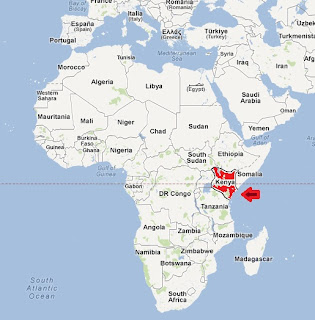KENYA
Kenya, officially the
Republic of Kenya, is located east of Africa, bordered by
Ethiopia to the north, Somalia to the east, Tanzania to the
south, Uganda to the west and South Sudan to the northwest.
Its
capital is Nairobi and its land area is 580,000square km. Kenya has 47 districts, each with a semi-autonomous government of the central government in Nairobi.
Its population consists of 39 million people with many cultures and backgrounds.
In Kenya is Mount Kenya, which gives its name to the country, and is the second highest mountain in Africa.
Its population consists of 39 million people with many cultures and backgrounds.
In Kenya is Mount Kenya, which gives its name to the country, and is the second highest mountain in Africa.
 |
| Mount Kenya |
Kenya
has highly variable demographics: there are areas of savannas, arid and semi-arid, and a large Indian Ocean coastline. The central and western regions are forests and mountains while the northern regions are more arid.
Kenya's economy is also the largest GDP of the eastern and central Africa. The country has been a traditional producer of tea and coffee, and more recently has focused on the export of cut flowers to Europe. Kenya is also a world power in sports.
 |
| Tea plantation |
HISTORY
The
colonial history of Kenya begins with the establishment of a German protectorate over the coastal possessions of the Sultan of Zanzibar in 1885, followed by the arrival of the British East African Company in 1888. Incipient imperial rivalry ended when Germany gave its coastal holdings to Britain in 1890.
It was the Kenya African National Union of Jomo Kenyatta the political force that formed the first government after independence in Kenya on 12 December 1963. Kenyatta became the leader of the country at first as Prime Minister and, from 1964, when Kenya became a republic, the first President of the Republic.
 |
| Jomo Kenyatta |
Despite the fears of the settlers, the Kenyatta government was moderate, pro-Western and progressive. Although Kenya in the late 1960's was, in fact, a one-party state were allowed considerable freedom within the party and the government rarely abused in their performances. The moderate and stable political government of Kenyatta attracted a large number of foreign investors, established a new industrial area near Thika, and modernized central Nairobi. The tourism industry, based on the great national wildlife reserves, expanded rapidly to become the largest source of foreign exchange. Kenyatta was recognized at the time of his death in 1978 as Mzee (old witch), not only for its own people but by a wide range of world leaders.




1 comentario:
Good job, Angela
:)
Publicar un comentario